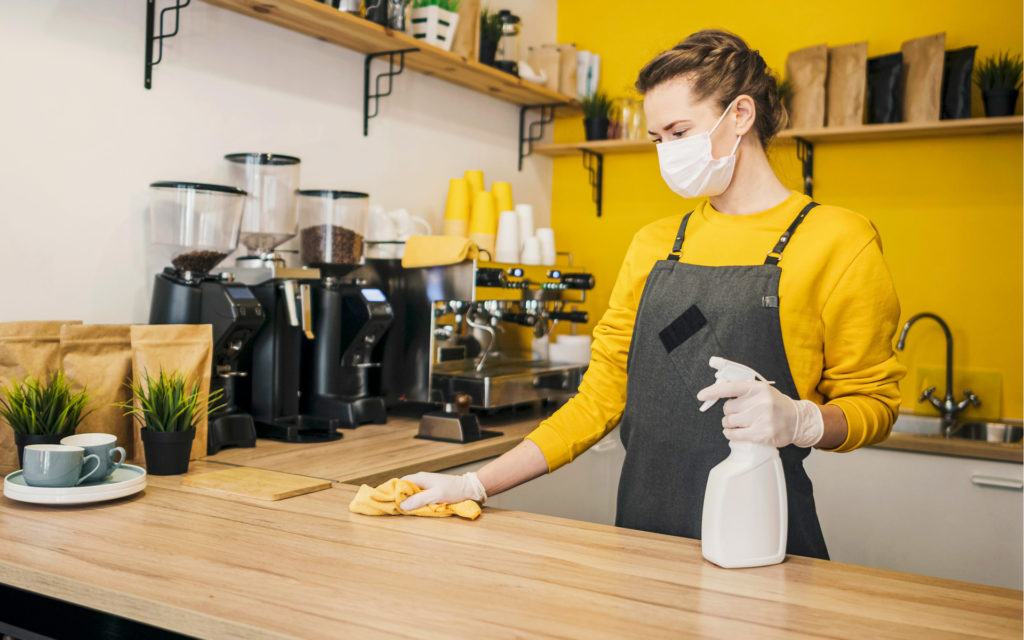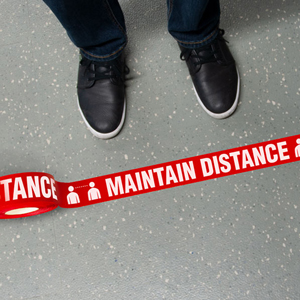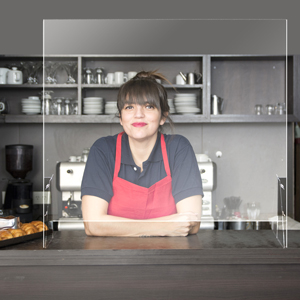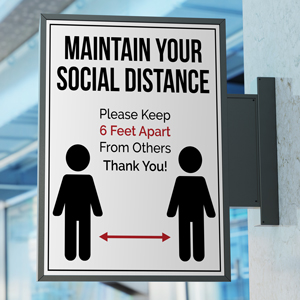
Keeping shoppers safe has always been part of the retail playbook. But the pandemic added a whole new, complicated chapter. Suddenly, your store layout could be a liability and your supply chain a huge question mark. The logistics of managing retail coronavirus safety—from new cleaning protocols to designated pickup zones—became a top priority overnight. For businesses struggling to adapt, it can feel like an impossible task. We'll break down the essential operational changes you can make to create a safer environment for everyone and keep your business running smoothly.
Whether you're in an area where you can remain open or you're down to a skeleton crew that's working to fulfill online orders, there's a lot you can do to keep your employees and customers safe. Even better, implementing heightened health and safety policies now means you can easily continue when stores re-open and people emerge from self-isolation. Here are a few tips to ensure a safe retail environment and prevent the spread of coronavirus.
The Unprecedented Shift in the Retail Landscape
The COVID-19 pandemic was a true "black swan event"—an unpredictable occurrence with extreme consequences that reshaped retail across the globe. For businesses accustomed to steady foot traffic and predictable sales cycles, the sudden closures and shifts in consumer behavior created immense challenges. The disruption forced a rapid evolution, pushing years of change into a matter of months. Retailers had to rethink everything from their supply chains to their customer interactions, all while managing the health and safety of their employees and shoppers. This period wasn't just a temporary hurdle; it marked a fundamental change in the way retail operates, accelerating trends that were already on the horizon and introducing entirely new ones.
Understanding the "Black Swan Event"
The term "black swan event" perfectly captures the sudden and disruptive nature of the pandemic's effect on retail. According to one study, the pandemic caused significant problems for retail businesses worldwide, forcing them to adapt or risk closure. Unlike a typical economic downturn, this crisis was driven by a public health emergency, which added layers of complexity. Retailers weren't just dealing with less disposable income; they were managing government mandates, supply chain breakdowns, and a fundamental shift in where and how people felt safe to shop. This unprecedented situation required a level of agility and creativity that many businesses had never needed before, pushing them to innovate on the fly.
A Look at the Economic Impact
The financial toll was immediate and widespread. In 2020, overall retail sales experienced their largest yearly drop on record, falling by 1.9% compared to 2019. This decline was felt across nearly every sector, as lockdowns and safety concerns kept shoppers at home. For national chains and multi-location businesses, the impact was magnified, with high overhead costs for physical stores that were suddenly generating little to no revenue. The economic shockwave forced companies to make tough decisions about staffing, inventory, and even store closures, all while trying to figure out a path forward in a completely new economic landscape.
The Acceleration of E-commerce
While in-store sales plummeted, e-commerce experienced a massive surge. Online sales soared to a record high, accounting for 33.9% of all retail spending—a significant jump from just 20% before the pandemic. This wasn't just a trend; it was a lifeline. Retailers who already had a strong online presence were better positioned to weather the storm, while those who didn't had to scramble to build their digital storefronts. This rapid shift highlighted the importance of a flexible, multi-channel approach and proved that a digital-first mindset was no longer optional for survival and growth in the modern retail environment.
Changes in Consumer Behavior and Confidence
Beyond the economic numbers, the pandemic fundamentally altered consumer behavior and priorities. Safety became the new currency of customer loyalty. Shoppers began to favor businesses that clearly communicated their health protocols and offered low-contact ways to shop. Convenience also took on new meaning, with services like curbside pickup and local delivery becoming standard expectations rather than perks. This shift forced retailers to look beyond the transaction and focus on building trust. Creating a safe and seamless experience, whether online or in-store, became the most important way to retain customers and encourage them to keep coming back during uncertain times.
Adapting Your Retail Strategy for a New Era
Thriving in this new environment requires more than just temporary fixes; it demands a strategic overhaul of how you do business. The most successful retailers are those who have embraced change and adapted their models to meet new customer expectations head-on. This means integrating digital and physical channels, re-evaluating what you sell and how you sell it, and making smart financial decisions to ensure long-term stability. It's about building a more resilient and flexible business that can handle future disruptions. For multi-location retailers, this also means ensuring consistency across all stores, so customers know they can expect the same safe and convenient experience no matter where they shop.
Embracing Online and Contactless Sales Models
The single most important adaptation for many retailers has been the move to online and contactless sales. E-commerce is no longer just another channel; it's a core component of the modern retail experience. For businesses that relied heavily on foot traffic, this meant quickly building or improving their online stores. But it's not just about having a website. It's about creating a smooth, user-friendly digital experience that mirrors the quality of your in-person service. This includes offering flexible fulfillment options that give customers control over how they receive their purchases, making the entire process as safe and convenient as possible.
Curbside Pickup, Local Delivery, and Drive-Through
Giving customers flexible and safe ways to get their products became essential. Options like curbside pickup, local delivery, and drive-through services quickly went from niche offerings to mainstream expectations. As Square suggests, letting customers order online or by phone for in-store or curbside pickup is a powerful way to maintain sales while prioritizing safety. Implementing these services often requires rethinking your physical space. You may need to create designated pickup zones, invest in clear signage, or even redesign your storefront to accommodate new traffic patterns. This is where thoughtful custom fixtures and displays can make a huge difference in creating an efficient and branded experience.
Implementing Contactless Payment Systems
Reducing physical contact at the point of sale is another critical adaptation. Implementing contactless payment systems is a key way to make transactions safer and more hygienic for everyone involved. This could mean enabling tap-to-pay for credit cards, accepting mobile wallet payments like Apple Pay and Google Pay, or sending digital invoices. To support this shift, you might need to reconfigure your checkout counters to accommodate new hardware and create a more spacious, socially distanced queue. A well-designed point-of-purchase area can guide customers smoothly through the payment process while reinforcing your commitment to their safety.
Re-evaluating Product Offerings and Financials
The pandemic didn't just change how people shop; it also changed what they buy. With more time spent at home, demand shifted toward products related to comfort, home improvement, entertainment, and wellness. At the same time, the economic uncertainty made careful financial management more important than ever. Successful retailers have been paying close attention to these trends, adjusting their inventory to match new customer demands and tightening their budgets to protect their bottom line. This proactive approach to product and financial planning is key to staying relevant and resilient in a rapidly changing market.
Meeting New Customer Demands
Staying in tune with your customers' evolving needs is crucial. This means using sales data and customer feedback to identify which products are selling and which are not. For many retailers, this led to a pivot toward stocking more loungewear, home office supplies, kitchen gadgets, and fitness equipment. It's also a good time to think about how your store's layout and displays can highlight these in-demand items. By strategically merchandising the products your customers are looking for now, you can make their shopping experience easier and more relevant, which can lead to increased sales and loyalty.
Smart Financial Management
In times of uncertainty, cash flow is king. It's essential to have a clear picture of your finances and to manage your expenses carefully. This could involve renegotiating with vendors, reducing non-essential spending, or seeking out financial assistance programs. It's also a good time to review your inventory costs and make sure you're not tying up too much capital in slow-moving products. By taking a disciplined approach to your finances, you can build a stronger foundation for your business and ensure you have the resources to invest in new opportunities as the retail landscape continues to evolve.
Managing Supply Chain and Inventory Challenges
The pandemic exposed the vulnerabilities in global supply chains like never before. With factory closures, shipping delays, and border restrictions, getting products from manufacturers to store shelves became a major hurdle. These disruptions forced retailers to become more strategic and creative with their inventory management. Instead of relying on a single source, many began diversifying their suppliers and exploring more local options. The key takeaway has been the need for greater visibility and flexibility in the supply chain to better anticipate and respond to unexpected challenges, ensuring you have the products your customers want, when they want them.
Addressing Global Supply Chain Disruptions
Early in the pandemic, many retailers felt the immediate impact of factory closures abroad. As The Boutique Hub noted, widespread closures in China threatened to cause significant shortages for retailers who relied on overseas manufacturing. This highlighted the risks of depending too heavily on a single region for production. To mitigate these risks, businesses have started exploring a mix of domestic and international manufacturing options. Having a diversified manufacturing and supply strategy provides a crucial buffer against regional disruptions, whether they're caused by a health crisis, trade disputes, or natural disasters, making your entire operation more resilient.
Strategic Inventory Management
When supply chains are unpredictable, smart inventory management becomes critical. It's no longer enough to simply react to shortages; retailers need to be proactive. This means using data to forecast demand more accurately, identifying your most important products, and maintaining a healthy level of safety stock. It also involves being creative with what you have. If a popular item is out of stock, can you promote a similar alternative? Can you bundle items to create new offers? A proactive and flexible approach to inventory ensures you can continue to meet customer needs even when faced with supply chain uncertainty.
Finding Opportunities Through Collaboration
Tough times often inspire creative partnerships. Many retailers have found success by collaborating with other local businesses or even competitors. This could look like co-hosting a virtual event, creating a joint marketing campaign, or sharing resources to reduce costs. For example, a group of small retailers might band together to negotiate better shipping rates or share a local delivery service. By working together, businesses can pool their strengths, reach new audiences, and find innovative solutions to common challenges. This spirit of collaboration can build a stronger, more supportive business community that benefits everyone involved.
Connecting with Customers in a Changing World
In an environment where physical distance is the norm, finding ways to connect with customers on a human level is more important than ever. The focus has shifted from purely transactional relationships to building genuine community and trust. This means communicating openly, creating a consistent and seamless experience across all your channels, and using what you know about your customers to make their interactions with your brand more personal and meaningful. By investing in these relationships, you can build a loyal customer base that will stick with you through good times and bad, because they feel seen, heard, and valued.
The Importance of Proactive Communication
Keeping your customers informed is essential for building trust and maintaining sales. During times of change, people want to know what to expect. Use your email list and social media channels to clearly communicate any changes to your store hours, safety protocols, or shopping options. It's also a great way to let customers know how they can continue to support your business, whether it's by buying gift cards, shopping online, or leaving a positive review. Honest and frequent communication shows your customers that you care and helps keep your brand top-of-mind, even if they can't visit your store in person.
Creating a Seamless Omnichannel Experience
Today's customers don't see channels; they just see your brand. They expect a consistent and connected experience whether they're browsing on their phone, shopping on your website, or visiting your physical store. This is the essence of an omnichannel strategy. It means ensuring that your branding, messaging, and customer service are aligned everywhere. For example, a customer should be able to easily buy a product online and return it in-store without any friction. As one report highlights, providing an excellent and connected experience across all shopping methods is a key challenge for modern retailers, but getting it right is a powerful way to build lasting loyalty.
Using Data to Personalize the Customer Journey
Personalization is what turns a good customer experience into a great one. By using customer data—like past purchases, browsing history, and preferences—you can tailor your marketing messages and product recommendations to be more relevant to each individual. This makes customers feel understood and valued, which can significantly improve engagement and sales. For example, you could send a targeted email to a customer about new arrivals in a category they've purchased from before. This data-driven approach allows you to create a more seamless and personalized journey that meets customers where they are and shows them exactly what they're looking for.
Keeping Your Retail Space Clean and Safe
According to CDC Interim Guidance for Businesses, you need to step up your game when it comes to cleaning and disinfecting your facility. This starts by using approved disinfectants that meet EPA standards for use against SARS-CoV-2 (COVID-19), and you can refer to the list they provide, which includes information about product names, active ingredients, the surfaces each product is used on, and more.
From there, you have to implement more stringent cleaning practices. While you're already used to dusting shelves, wiping down counters, and cleaning on-site bathroom facilities, protecting against the spread of COVID-19 demands more.
For starters, you need to routinely clean and disinfect surfaces that are touched often, including door handles, shelving and bins, counters, POS systems (keypads, touch screens, cash drawers, etc.), and even pens. You can clean bathroom facilities and surfaces throughout your space frequently, but to keep employees and customers safe, consider providing no-touch sanitary door openers and place hand sanitizers throughout your space.
How Store Layout and Fixtures Can Promote Safety
Your store's layout is a silent guide for every customer who walks through the door. By strategically placing fixtures, you can create clear pathways that naturally encourage safe distancing and prevent bottlenecks in high-traffic areas. Think about creating wider aisles or even one-way systems to manage the flow of shoppers. This isn't just about following guidelines; it's about making customers feel comfortable and secure, which encourages them to stay longer and return. A well-planned layout can significantly reduce congestion and make the entire shopping experience feel safer and more organized for everyone involved.
At S-CUBE, we've seen firsthand how thoughtful design and custom fixtures can help manage customer flow and create safer, more efficient shopping environments. Redesigning checkout counters or creating designated pickup areas are just a couple of ways to adapt the physical store.
At S-CUBE, we've seen firsthand how thoughtful design and custom fixtures can help manage customer flow and create safer, more efficient shopping environments. Redesigning checkout counters with protective barriers or creating designated pickup areas for online orders are just a couple of ways to adapt the physical store. For example, creating a dedicated space for curbside or in-store pickups helps control how many people are in your store at once. Our team specializes in designing and engineering custom solutions that not only meet safety needs but also align with your brand's aesthetic, ensuring a seamless and positive customer experience.
Promoting Hygiene for Staff and Shoppers

Social Distancing Floor Graphics

Sneeze Guards & Barriers

Social Distancing Signage & Sign Holders
Encouraging good hygiene and social distancing is a major step in protecting the health and safety of anyone who enters your store. Adding a sanitizing station like providing wipes and hand sanitizer is a great start. but from there you'll want to post signs to promote six feet of social distance, and place floor marking anywhere customers line up (at the POS counter or outside the store, for example).
You should encourage hygiene practices such as providing sneeze guard and protective screen at checkout and service areas, and wiping down frequently-touched items (shopping carts/baskets, door handles, bathroom surfaces, POS and counters, etc.) before and after use. To operate safely in the long run, you should also assign protective personal equipment such as face masks, face shields, latex gloves to employees and workers.
Clear Policies for Employee Health
Your team's health is just as important as your store's cleanliness. Establishing clear, written policies for employee health is a critical step in creating a safe environment for everyone. These guidelines should outline exactly what an employee should do if they feel sick, the procedures for taking time off, and the requirements for safely returning to work. It's essential to talk with your employees to develop a plan that makes sense for your team and ensures everyone feels supported. Having these protocols ready before an issue arises shows your team you are prepared and value their well-being. This proactive step builds trust and helps you maintain a healthy, reliable workforce.
Moving Forward Safely in Retail
With the right changes in place, retail spaces have the best opportunity to protect against health threats and keep employees and customers safe.
S-CUBE is here to help as much as we can. We will leverage our experience, resources, and products to help you and your business get through this and ready to thrive on the other side. Let’s work together to find ways to help you succeed during this unprecedented time, contact us to get started today!
Building a Resilient Plan for the Future
The pandemic acted as a major wake-up call for the retail industry, highlighting the need for more than just a reactive crisis plan. This kind of unexpected, disruptive event showed that true stability comes from building a resilient foundation for the future. Creating a proactive strategy is essential for withstanding the next challenge, whatever it may be. Businesses must have plans ready for unexpected events to keep their operations going, from diversifying supply chains to fully embracing the continued growth of e-commerce. It also means rethinking the physical store itself, designing flexible layouts with adaptable fixtures that can quickly pivot to meet new customer expectations or safety requirements.
Frequently Asked Questions
How can I make my physical store feel safer without sacrificing my brand's atmosphere? The key is to integrate safety measures into your store's design rather than just adding them on top. Think of it as a design challenge. You can use custom fixtures and strategic layouts to create wider, more intuitive pathways that guide customers and prevent crowding. Well-designed protective barriers at checkout can match your brand's aesthetic, and clear, stylish signage can communicate safety protocols in a way that feels helpful, not alarming. When safety feels like a natural part of the shopping experience, it builds trust and makes customers feel cared for.
We quickly added services like curbside pickup. How do we make them a permanent, efficient part of our business? To make these services last, you need to move them from a temporary fix to a fully integrated feature. This often means rethinking your physical space. Consider creating a dedicated, branded area for order pickups so the process is smooth for both customers and staff. Custom shelving and storage solutions can keep orders organized and prevent mix-ups. The goal is to create a seamless link between your online order system and your physical location, making it just as easy and reliable as shopping in-store.
My supply chain was a major challenge. What's a realistic first step to make it more reliable? The most effective first step is to focus on diversification. Relying on a single manufacturing source or region creates a significant vulnerability. Start by exploring a mix of domestic and international suppliers for your key products or fixtures. This doesn't mean you have to completely overhaul your entire supply chain overnight, but having alternative options provides a crucial buffer against regional shutdowns, shipping delays, or other unexpected disruptions, making your entire operation more resilient.
With fewer people shopping in person, how can we maintain a strong connection with our customers? This is where your communication and digital presence become so important. Your goal is to create a consistent brand experience, no matter where customers interact with you. Use your email and social media channels to share stories, offer value, and keep people informed—not just to announce sales. Ensure your website is easy to use and that your customer service is just as helpful online as it is in person. When you treat every channel as an opportunity to build a relationship, you create a loyal community that stays connected to your brand.
We made a lot of temporary changes to get by. How do we build a long-term strategy that's truly resilient? Building resilience means shifting your mindset from reacting to crises to proactively building flexibility into your business model. Look at the changes you made and identify what worked best. A truly resilient strategy often includes a strong e-commerce platform, a diversified supply chain, and a physical store layout that can be easily adapted. It's about creating a business that can pivot smoothly when the next unexpected event occurs, ensuring you can continue to serve your customers effectively.
Key Takeaways
- Merge Your Digital and Physical Worlds: Your customers move seamlessly between online and in-store, and your business should too. Connect your e-commerce site with convenient fulfillment options like curbside pickup to create a flexible, modern shopping experience.
- Rethink Your Floor Plan for Confidence: Your store's layout directly impacts how safe customers feel. Use strategic fixtures and clear signage to manage foot traffic, prevent crowding, and show shoppers that their well-being is a top priority.
- Build a Proactive and Resilient Operation: Don't wait for the next disruption to prepare. Diversify your supply chain to protect against shortages and communicate openly with your customers to build the trust and loyalty needed to weather any storm.
Related Articles
Keep your space ahead of the curve.
Subscribe for expert insights on fixture design, materials, and modern retail environments.


